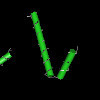?
 
CSN4/RPN5/eIF3a helix turn helix domain Cullin-RING E3 ubiquitin ligases (CRLs) are regulated by the eight-subunit COP9 signalosome (CSN). Enzymatically, CSN functions as an isopeptidase that removes the ubiquitin-like activator NEDD8 from CRLs, but it can also bind deneddylated CRLs and maintain them in an inactive state. The CSN subunits CSN1, CSN2, CSN3, CSN4, CSN7 and CSN8, share a common domain composition: an N-terminal array of tandem alpha-helical tetratricopeptide/-like repeats, a 34 residue motif, followed by a PCI domain, which encompasses a WH subdomain, a linker, and one or two alpha-helices at the C-terminus. This entry describes the C-terminal helices found on CSN4. The two helices from CSN4 (helices I and II) form a brace roughly perpendicular to the bundle axis in contact with the three C-terminal helices of CSN6. CSN5, whose two C-terminal helices form an antiparallel hairpin, inserts its final C-terminal helix (helix II) into the central CSN6 framework at the core of the bundle. Both CSN1 and CSN4 are dependent on the presence of their C-terminal helix (CSN1 isoform-2 residues: 466-527; and CSN4: 364-406) for integration into CSN. COP9 signalosome shares common architecture with the 26S proteasome lid and eIF3 where the 19S lid subunit RPN5 and the eIF3 core subunit eIF3a share significant structural similarity with CSN4. |
